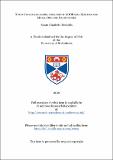Files in this item
X-ray crystallographic analysis of ADORable zeolites and metal-organic frameworks
Item metadata
| dc.contributor.advisor | Morris, Russell Edward | |
| dc.contributor.author | Henkelis, Susan Elizabeth | |
| dc.coverage.spatial | xii, 210 p. | en_US |
| dc.date.accessioned | 2019-06-18T14:38:49Z | |
| dc.date.available | 2019-06-18T14:38:49Z | |
| dc.date.issued | 2019-06-26 | |
| dc.identifier.uri | https://hdl.handle.net/10023/17923 | |
| dc.description.abstract | This thesis largely focuses on the mechanistic analysis of the Assembly-Disassembly- Organisation-Reassembly (ADOR) process through a range of crystallographic techniques including powder X-ray diffraction and Pair Distribution Function (PDF) analysis and subsequent analysis using solid-state kinetics. Chapter 4 describes the development of a new standard protocol to using the ADOR process. The protocol describes the development of a procedure used for identifying the optimum conditions (time of reaction, temperature, acidity, etc.) for the ADOR process. In developing the protocol, Ge-containing UTL zeolites were subjected to hydrolysis conditions using both water and hydrochloric acid as media, which provides an understanding of the effects of temperature and pH on the Disassembly (D) and Organisation (O) steps of the process that define the potential products. Samples were analysed by powder X-ray diffraction to yield a time course for the reaction at each set of conditions. Chapter 5 continues work on the ADOR process and presents the first kinetic study on the two most prominent steps in the process; Disassembly and Organisation. By using solid- state kinetic models, Avrami-Erofeev and its linear equivalent Sharp-Hancock, the dependence on temperature and presence of liquid water was investigated and the activation energy of the rearrangement process quantified. Work on the rearrangement step aimed to understand where the silica species intercalates from and which material formed as the kinetic and thermodynamic product from the reaction. Chapter 6 describes a study into the Disassembly and Organisation steps of the ADOR process through in situ Pair Distribution Function (PDF) analysis. This hopes to shed light on the selectivity of the ADOR process in different media and the mechanism by which the double-four-ring (d4r) breakdown. On a different note, Chapter 7 describes the refinement of synthesis conditions used to prepare poly-crystalline CPO-27-M (MOF-74) with lower concentrations of base and at low temperature. Refinement of the synthesis of single crystal CPO-27-Mg, -Zn and UTSA-74 was undertaken and the necessary components to forming large single crystals understood. | en_US |
| dc.language.iso | en | en_US |
| dc.publisher | University of St Andrews | |
| dc.subject.lcc | TP159.M6H4 | |
| dc.subject.lcsh | Zeolites--Synthesis | en |
| dc.subject.lcsh | X-ray crystallography | en |
| dc.title | X-ray crystallographic analysis of ADORable zeolites and metal-organic frameworks | en_US |
| dc.type | Thesis | en_US |
| dc.type.qualificationlevel | Doctoral | en_US |
| dc.type.qualificationname | PhD Doctor of Philosophy | en_US |
| dc.publisher.institution | The University of St Andrews | en_US |
| dc.identifier.doi | https://doi.org/10.17630/10023-17923 |
This item appears in the following Collection(s)
Items in the St Andrews Research Repository are protected by copyright, with all rights reserved, unless otherwise indicated.

